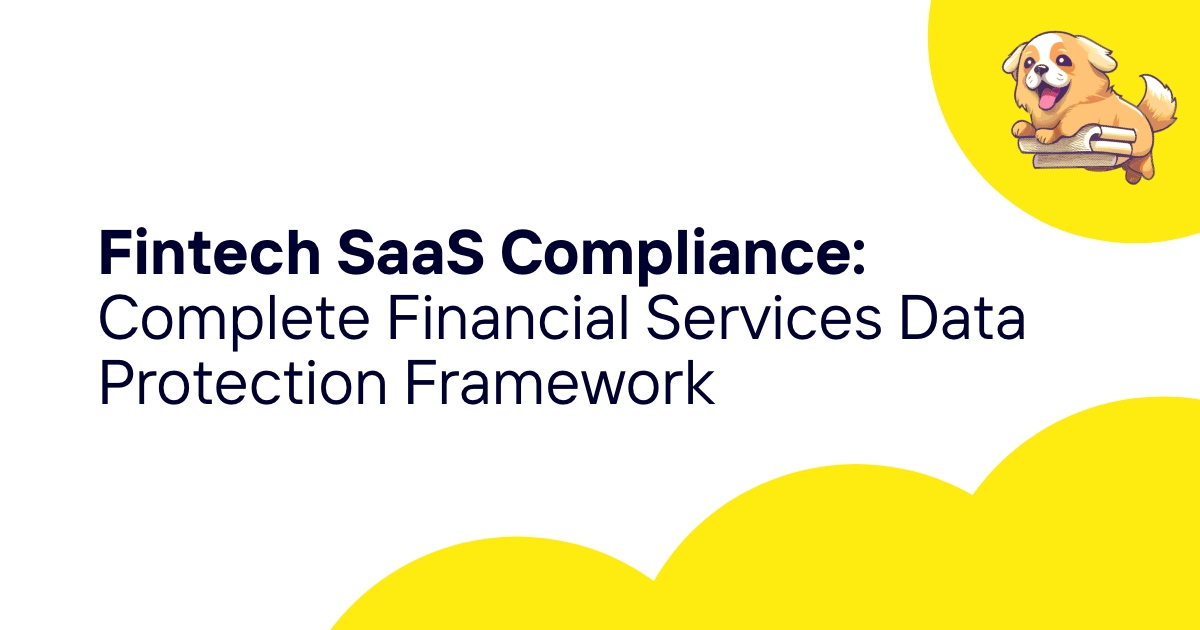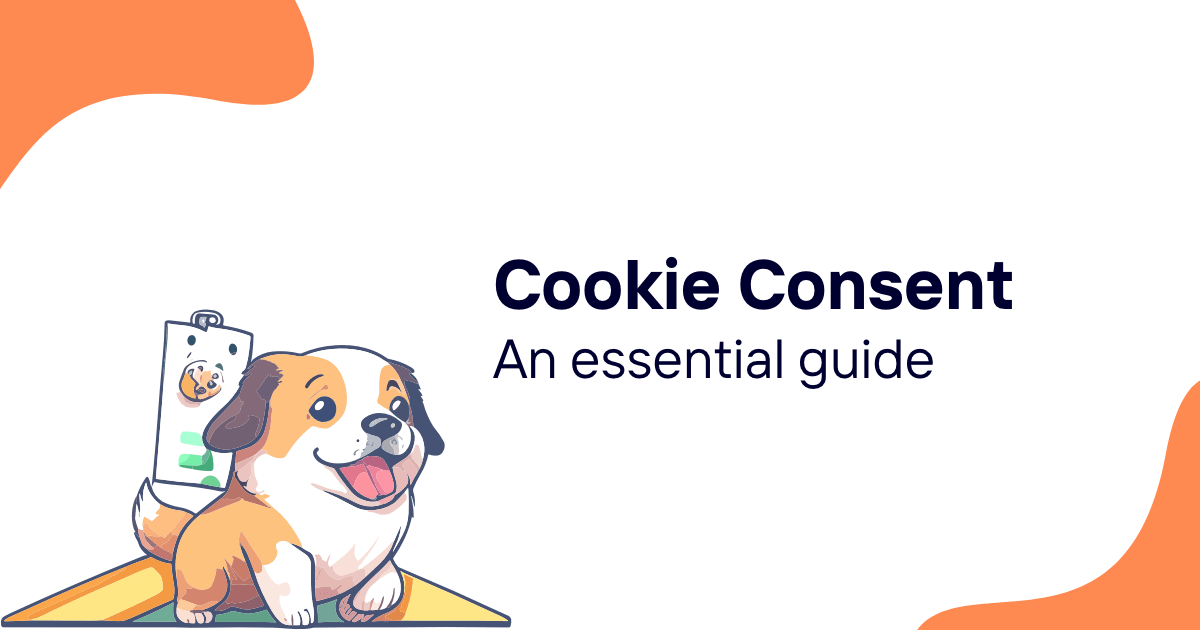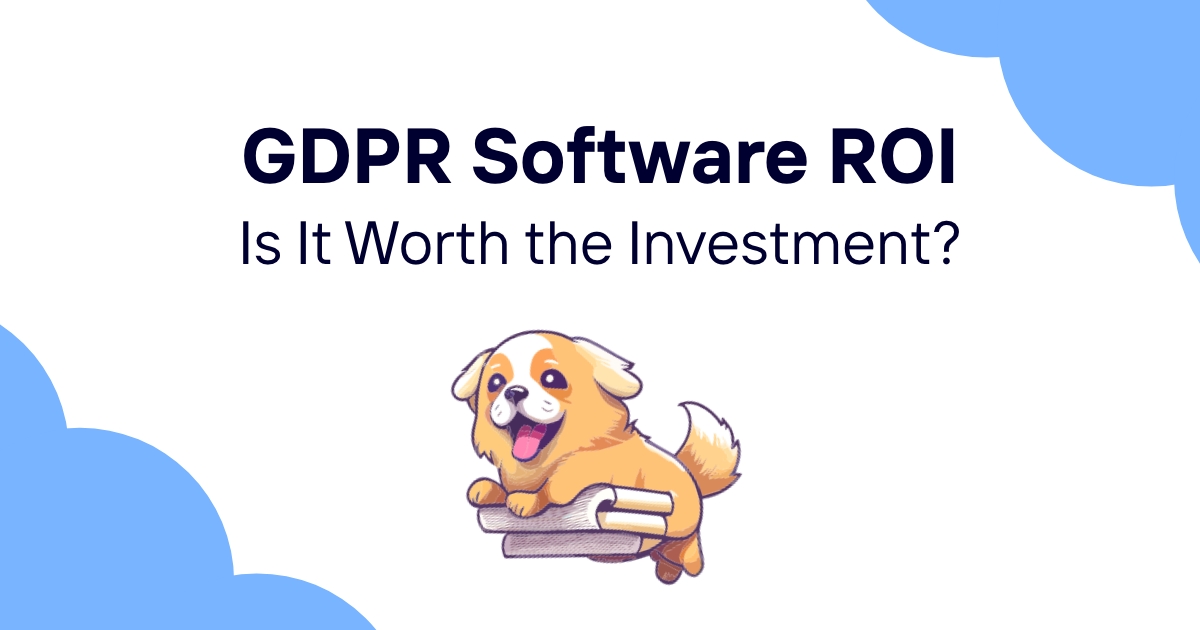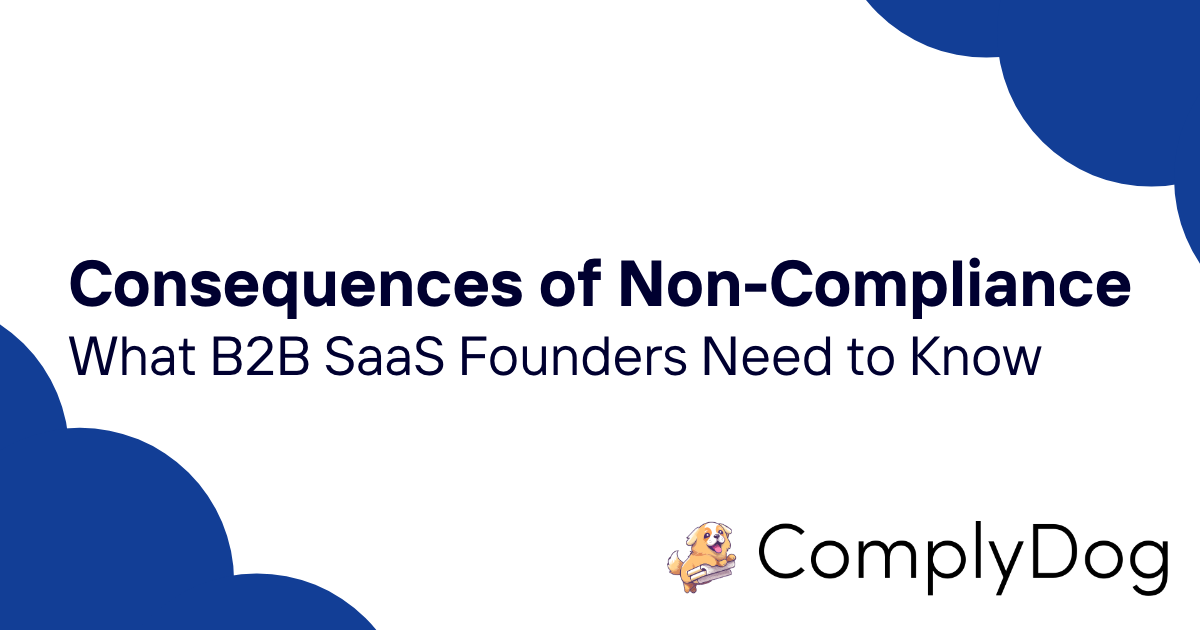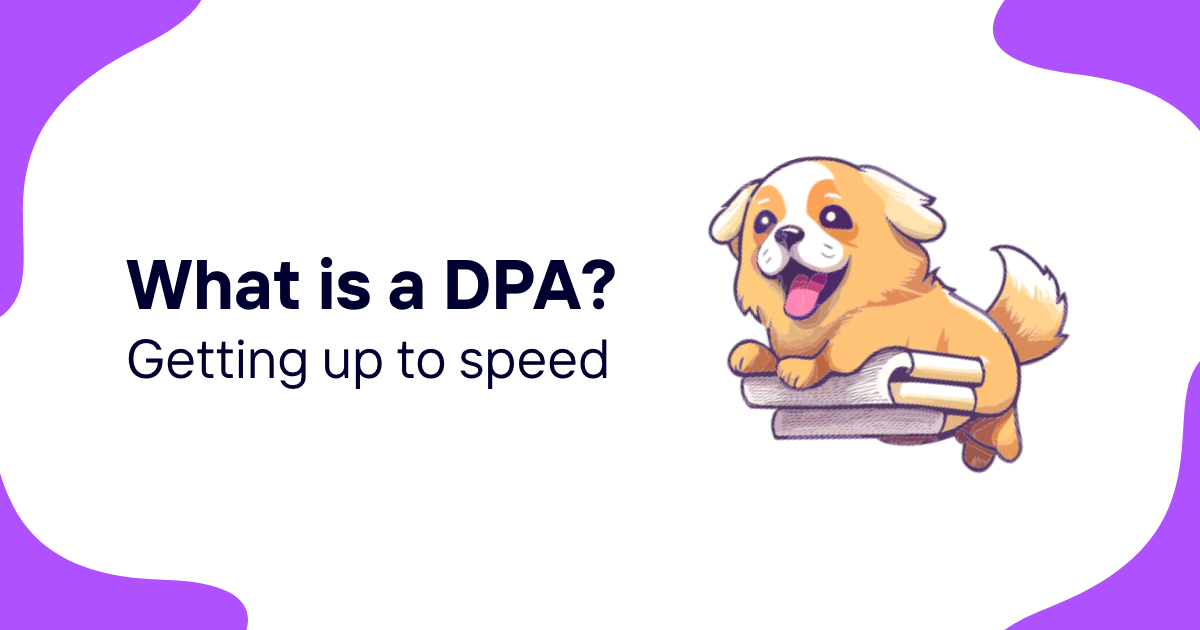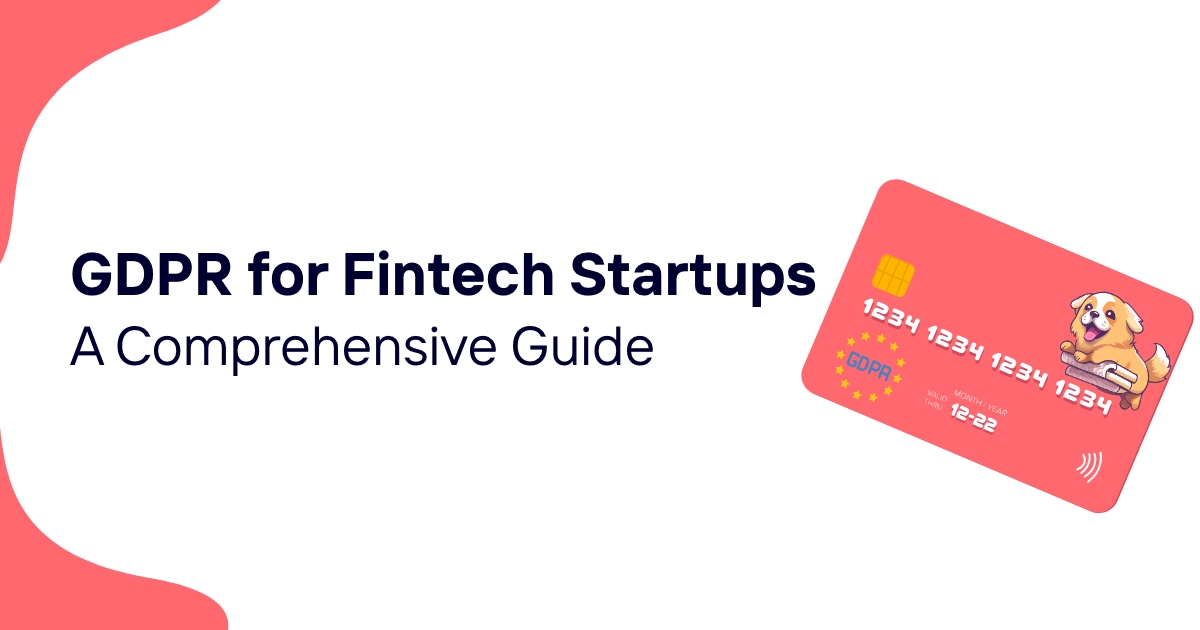Fintech SaaS companies operate in one of the most regulated industries on the planet. You're dealing with financial data, payment information, and personal details that attract regulators like honey draws bees. Get it wrong, and you're not just looking at fines - you could lose your ability to process payments entirely.
The regulatory maze includes PCI DSS for payment data, GDPR for European customers, SOX for public companies, and a dozen other acronyms that keep compliance teams awake at night. Each regulation comes with its own requirements, timelines, and penalty structures that can overlap in confusing ways.
But here's what experienced fintech SaaS companies know: compliance isn't just about avoiding penalties. It's your competitive advantage. Financial institutions won't touch vendors who can't demonstrate rock-solid data protection. Your compliance posture directly impacts your ability to land enterprise deals and expand internationally.
Building a comprehensive compliance framework takes time, but the alternative is much worse. Companies like ComplyDog help fintech SaaS platforms centralize their compliance efforts and demonstrate their commitment to data protection through transparent compliance portals.
Fintech SaaS Regulatory Landscape Overview
The fintech regulatory landscape changes faster than most companies can keep up. New regulations pop up regularly, existing ones get updated, and enforcement priorities shift based on political winds and high-profile breaches.
Core Regulations for Fintech SaaS:
- PCI DSS - Payment card data protection requirements that apply when you store, process, or transmit cardholder data
- GDPR - European data protection regulation covering all personal data of EU residents
- PSD2 - European payment services directive requiring strong customer authentication and open banking APIs
- SOX - Sarbanes-Oxley requirements for public companies and their service providers
- CCPA - California Consumer Privacy Act affecting businesses serving California residents
- Financial industry-specific regulations - Varies by country and financial services sector
The challenge isn't just understanding individual regulations - it's figuring out how they interact. PCI DSS and GDPR both cover payment data but from different angles. PSD2 creates data sharing requirements that must comply with GDPR privacy rules. SOX demands specific controls that overlap with other security frameworks.
Regional Variations:
Financial regulations vary significantly by jurisdiction. What works for US fintech companies might violate European banking laws. Asian markets have their own requirements that don't always align with Western standards.
Before expanding into new markets, map out the regulatory requirements specific to that region. Don't assume your existing compliance program will transfer directly. Some countries require local data residency, specific encryption standards, or regulatory approval before you can serve financial institutions.
Enforcement Trends:
Regulators are getting more aggressive about fintech compliance. Gone are the days when startups could fly under the radar while building their compliance programs. Today's enforcement actions target companies of all sizes, with penalties that can shut down promising businesses overnight.
Focus on building compliance into your product from day one rather than retrofitting it later. Technical debt in compliance is expensive and time-consuming to fix, especially when you're trying to close enterprise deals that require extensive security reviews.
PCI DSS and GDPR Integration for Financial SaaS
PCI DSS and GDPR create overlapping but distinct requirements for financial SaaS companies. Understanding where they align and where they conflict helps you build efficient compliance programs that satisfy both frameworks.
Data Protection Overlap:
Both regulations require strong encryption, access controls, and audit logging. Your technical safeguards can often satisfy requirements from both frameworks simultaneously, reducing implementation complexity.
PCI DSS focuses specifically on cardholder data environments, while GDPR covers all personal data processing. This means your PCI DSS scope might be smaller than your GDPR scope, but the security controls often overlap significantly.
Key Differences in Approach:
PCI DSS takes a prescriptive approach with specific technical requirements. You must use specific encryption algorithms, implement particular network security controls, and follow detailed testing procedures.
GDPR is more principles-based, requiring appropriate security measures based on risk assessment. This flexibility can be helpful, but it also means you need to justify your security decisions with documented risk analysis.
Compliance Timeline Conflicts:
PCI DSS requires annual assessments and quarterly vulnerability scans. GDPR mandates breach notification within 72 hours and requires ongoing privacy impact assessments for high-risk processing.
Your compliance calendar needs to account for both sets of requirements. Some companies find it helpful to align their PCI DSS assessment timing with GDPR compliance reviews to reduce administrative overhead.
Data Retention Challenges:
PCI DSS requires specific data retention periods for different types of cardholder data. GDPR demands data minimization and deletion when no longer necessary for the original purpose.
When the same data falls under both regulations, you need clear policies for handling retention conflicts. Generally, the more restrictive requirement takes precedence, but document your decision-making process for audit purposes.
Open Banking SaaS Data Protection Requirements
Open banking regulations like PSD2 create new data sharing requirements that fintech SaaS companies must handle carefully. These regulations enable innovation while requiring strong customer protection and consent management.
Strong Customer Authentication (SCA):
PSD2 requires strong customer authentication for electronic payments and account access. This means implementing multi-factor authentication that includes at least two independent elements from different categories.
SCA requirements apply to payment initiation, account information access, and certain remote electronic transactions. Your SaaS platform needs to support these authentication flows while maintaining user experience quality.
Consent Management Complexity:
Open banking consent is more complex than standard GDPR consent. Customers must understand exactly what data will be shared, with whom, and for how long. Consent must be specific, informed, and freely given.
Your consent management system needs to handle granular permissions, time-limited access, and easy withdrawal options. Customers should be able to see exactly what data they've authorized and revoke specific permissions without affecting others.
Third-Party Provider Integration:
Open banking requires secure integration with third-party providers (TPPs) who access customer data on behalf of fintech applications. These integrations must meet specific security and liability requirements.
Document your TPP onboarding process, security assessments, and ongoing monitoring procedures. Financial institutions will want to understand how you manage third-party risk before approving your platform for their customers.
API Security Requirements:
Open banking APIs must implement specific security measures including mutual TLS, message signing, and timestamp validation. These technical requirements go beyond standard API security practices.
Your API security framework should address open banking requirements from the design phase. Retrofitting security controls into existing APIs is expensive and often introduces compatibility issues with existing integrations.
For guidance on building comprehensive compliance frameworks, check out our healthcare SaaS compliance guide which covers similar multi-regulatory challenges.
Financial Customer Data Management in SaaS
Financial customer data requires special handling that goes beyond standard personal data protection. Financial information reveals spending patterns, creditworthiness, and other sensitive details that create additional privacy and security obligations.
Data Classification Framework:
- Cardholder data - Primary account numbers, cardholder names, expiration dates, service codes
- Sensitive authentication data - CVV codes, PIN verification values, magnetic stripe data
- Financial account information - Account numbers, balances, transaction history
- Identity verification data - Government ID numbers, biometric data, KYC documentation
- Behavioral data - Spending patterns, location data, device information
Each data category requires different protection levels and handling procedures. Your data mapping should clearly identify which regulations apply to each category and what specific controls are required.
Cross-Border Data Transfers:
Financial data transfers face additional restrictions beyond standard GDPR requirements. Some countries prohibit financial data from leaving their borders, while others require specific approvals for international transfers.
Research data residency requirements before expanding into new markets. Cloud provider regions, backup locations, and disaster recovery sites all need to comply with local financial data protection laws.
Data Retention Complexity:
Financial regulations often require longer retention periods than general data protection laws. Anti-money laundering rules might require keeping transaction data for five years, while GDPR pushes for data minimization.
Balance regulatory requirements with privacy principles by implementing automated retention policies that apply appropriate rules based on data classification and legal requirements.
Fintech SaaS Consent Management Strategies
Consent management in fintech goes far beyond simple checkbox agreements. Financial services require granular consent for specific data uses, with clear options for customers to control how their information is processed.
Granular Consent Options:
Customers should be able to consent to specific data processing activities without accepting everything as a package deal. This might include separate consent for transaction analysis, marketing communications, and third-party data sharing.
Your consent management system should track individual consent decisions and respect customer preferences across all processing activities. Bundled consent that forces customers to accept everything rarely holds up under regulatory scrutiny.
Dynamic Consent Updates:
Financial products evolve, and your data processing needs will change over time. Your consent management system should support dynamic updates that inform customers about new processing activities and request additional consent when needed.
Avoid blanket consent for future activities that you haven't defined yet. Customers need to understand exactly what they're agreeing to, and vague language about potential future uses won't satisfy regulatory requirements.
Consent Withdrawal Mechanisms:
Customers must be able to withdraw consent as easily as they gave it. This means providing clear withdrawal options in your application interface, not just buried in privacy policy links.
Consent withdrawal should be granular - customers should be able to stop specific processing activities without losing access to your entire platform. Design your systems to handle partial consent withdrawal gracefully.
Record Keeping Requirements:
Maintain detailed records of consent decisions, including when consent was given, what specific activities were authorized, and any subsequent changes. These records are critical for demonstrating compliance during audits.
Your consent records should include sufficient detail to recreate the exact consent interface the customer saw when making their decision. Screenshots, timestamps, and version tracking help defend consent decisions during regulatory reviews.
Financial Services SaaS Vendor Compliance
Financial institutions impose strict vendor compliance requirements that go beyond standard business agreements. Your vendor compliance program needs to address these heightened expectations while protecting your own business interests.
Due Diligence Documentation:
Financial institutions require extensive documentation of your security controls, compliance certifications, and risk management practices. Prepare comprehensive vendor packages that address common due diligence requirements.
Include third-party attestations like SOC 2 reports, PCI DSS certifications, and penetration testing results. Financial institutions want independent validation of your security claims, not just internal assessments.
Ongoing Monitoring Requirements:
Financial institutions don't just evaluate vendors once - they require ongoing monitoring of vendor compliance posture. Your compliance program should include regular reporting, incident notification procedures, and change management processes.
Proactive communication about security incidents, policy changes, and certification updates builds trust with financial institution customers. Don't wait for them to ask - provide regular updates on your compliance status.
Regulatory Examination Support:
When financial institutions undergo regulatory examinations, they may need to provide information about their SaaS vendors. Your compliance documentation should be organized to support these regulatory reviews.
Prepare standardized reports that address common regulatory questions about vendor risk management, data protection, and business continuity planning. Well-organized documentation reduces the burden on your customers during examinations.
Service Level Agreement Considerations:
Financial institution SLAs often include specific requirements for data protection, incident response, and business continuity. These requirements may be more stringent than your standard commercial terms.
Build flexibility into your SLA templates to accommodate financial institution requirements while protecting your operational capabilities. Some requirements may be reasonable for enterprise customers but impractical for smaller clients.
Fintech Compliance Technology Stack
Modern fintech compliance requires sophisticated technology tools that can handle multiple regulatory frameworks, automate routine tasks, and provide transparency to customers and regulators.
Compliance Management Platforms:
Centralized compliance platforms help fintech SaaS companies track requirements across multiple regulations, manage documentation, and generate reports for different stakeholders.
Look for platforms that support multiple regulatory frameworks and can adapt to changing requirements. Your compliance technology should reduce administrative overhead, not create additional complexity.
Automated Monitoring and Reporting:
Automated monitoring tools can track security metrics, detect policy violations, and generate compliance reports without manual intervention. These tools become critical as your compliance requirements scale with business growth.
Focus on tools that integrate with your existing infrastructure rather than requiring separate data collection processes. The best compliance monitoring happens transparently within your operational systems.
Customer-Facing Transparency Tools:
Financial institution customers increasingly expect self-service access to vendor compliance information. Compliance portals allow customers to review your security policies, download certifications, and track your compliance status.
ComplyDog provides fintech SaaS companies with compliance portal functionality that demonstrates commitment to data protection while reducing administrative overhead from customer compliance inquiries.
Documentation and Evidence Management:
Compliance requires extensive documentation that must be organized, searchable, and accessible during audits. Document management systems should support version control, access logging, and automated retention policies.
Your documentation system should make it easy to find relevant policies and evidence during regulatory examinations or customer due diligence reviews. Poor document organization can turn routine compliance activities into time-consuming manual searches.
Integration Considerations:
Your compliance technology stack should integrate with existing business systems to avoid creating operational silos. Compliance tools that require separate data entry or duplicate processes rarely get used consistently.
Look for platforms that offer APIs, webhook support, and integration with common business tools. The easier it is to maintain compliance data, the more likely your team will keep it current and accurate.
Ready to streamline your fintech compliance program? Use ComplyDog and demonstrate your commitment to financial data protection with a comprehensive compliance portal that builds customer trust and supports regulatory requirements.
